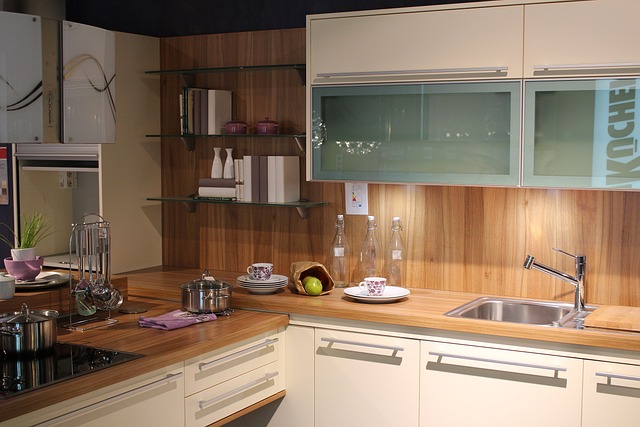When remodeling for an industrial kitchen, prioritize raw materials (like stainless steel and reclaimed wood), exposed brick walls, concrete floors, and metallic accents for a bold aesthetic. Balance functionality with design through open shelving, adjustable lighting, and seamless flooring while incorporating rustic charm with vintage hardware or jute rugs. Aim to create a dynamic, inviting space that leverages open layouts, central islands, and vertical storage to embody the unique industrial kitchen design.
Looking to transform your kitchen into a bold and functional space with an industrial flair? This guide is your compass. We explore innovative ideas to remodel your kitchen, blending raw materials, modern appliances, and unique décor for a captivating industrial kitchen design. From choosing the right elements to lighting schemes and personal touches, discover how to create a striking and practical space that’s perfect for today’s living. Uncover trends, key features, and expert tips to navigate this exciting renovation journey.
Choosing Industrial Elements for Kitchen Remodel
When remodeling your kitchen with an industrial-style in mind, selecting the right elements is key to achieving that desired aesthetic. Industrial kitchen design leans into raw, unapologetic materials and bold, structural features, so choose fixtures and finishes that reflect these characteristics. Opt for stainless steel appliances and hardware for a modern, sleek look, or go for rusted metal and concrete for a more rustic, industrial vibe.
Incorporating exposed brick walls, reclaimed wood floors, or even ductwork as decorative elements can add depth and character to your space. Don’t shy away from larger, statement-making pieces like a bold island in the center of the room or a towering hood above the stove. These features not only serve practical purposes but also become focal points that define your industrial kitchen design.
– Trends in industrial kitchen design
Industrial kitchen design has been a growing trend, appealing to those seeking a bold and functional space that feels both modern and ruggedly charming. This style often incorporates exposed brick walls, concrete floors, and metallic accents, creating an open and edgy atmosphere. The focus is on raw materials and a minimal, yet striking aesthetic. One of the key elements is maximizing natural light to balance out the industrial vibe, making the kitchen feel bright and inviting.
Trends in industrial kitchen design also emphasize smart storage solutions and versatile spaces that cater to modern living. Open shelving displays both functional items and decorative pieces, while adjustable lighting fixtures can transform the mood of the room. Incorporating rustic elements like reclaimed wood counters or vintage-inspired hardware adds warmth to the otherwise urban landscape, making these kitchens truly unique and personalized.
– Key features to incorporate
When remodeling your kitchen into an industrial-style space, focus on incorporating key features that define this aesthetic. First and foremost, exposed brick walls or concrete surfaces are essential elements of an industrial kitchen design. These raw materials bring a sense of urban loft living to your culinary space. Additionally, consider metal accents; think stainless steel appliances, faucets, and hardware, which add both functionality and a modern industrial touch. Open shelving is another must-have—it showcases your favorite cookware while providing ample storage.
For a true industrial vibe, incorporate seamless flooring options like concrete or polished wood, and don’t be afraid to expose and showcase any existing pipes for an authentic, rough-and-tough look. Lighting plays a crucial role here; hanging pendant lights over the island or table can create a dramatic effect, while task lighting ensures practicality during meal prep. Remember, the goal is to blend functionality with a bold, industrial design that’s both inviting and unique.
– Materials and finishes
When it comes to materials and finishes for an industrial kitchen remodel, the key is to choose elements that blend rustic charm with modern functionality. Think exposed brick walls or concrete surfaces for a raw, unforgiving look that’s characteristic of industrial design. Combine these with metal accents like stainless steel appliances and fixtures for a sleek, durable finish. Open-frame cabinets with a mix of wood and metal doors can add visual interest while providing ample storage.
For countertops, consider materials that are both visually appealing and easy to maintain—think concrete, quartz, or granite. These options not only complement the industrial aesthetic but also offer durability and ease of cleaning, which is essential in a high-traffic kitchen space. Incorporate contrasting textures with area rugs made from jute or sisal for warmth underfoot, adding another layer of depth to your industrial kitchen design.
Layout and Space Planning Tips
When planning the layout for an industrial-style kitchen, it’s essential to consider open and efficient space utilization. This design philosophy is closely tied to the esthetics of industrial kitchens, which often feature raw, exposed elements. Opt for a layout that promotes ease of movement between preparation areas, stove, sink, and storage. A central island or a long, functional counter can serve as a versatile work surface and gathering spot, bringing life to the space.
Incorporate clever storage solutions like tall cabinets with open shelves, industrial-style piping, or suspended storage to maximize vertical space. This not only keeps your kitchen organized but also adds to its distinctive industrial charm. Remember, in an industrial kitchen design, functionality should seamlessly blend with aesthetics, creating a dynamic and inviting culinary hub.
A successful industrial-style kitchen remodel combines functionality with bold design choices. By incorporating trendy elements, such as exposed pipes and concrete, along with strategic space planning, you can create a vibrant, efficient, and unique culinary hub. Remember to select materials that suit your lifestyle while enhancing the overall aesthetic of your industrial kitchen design.
